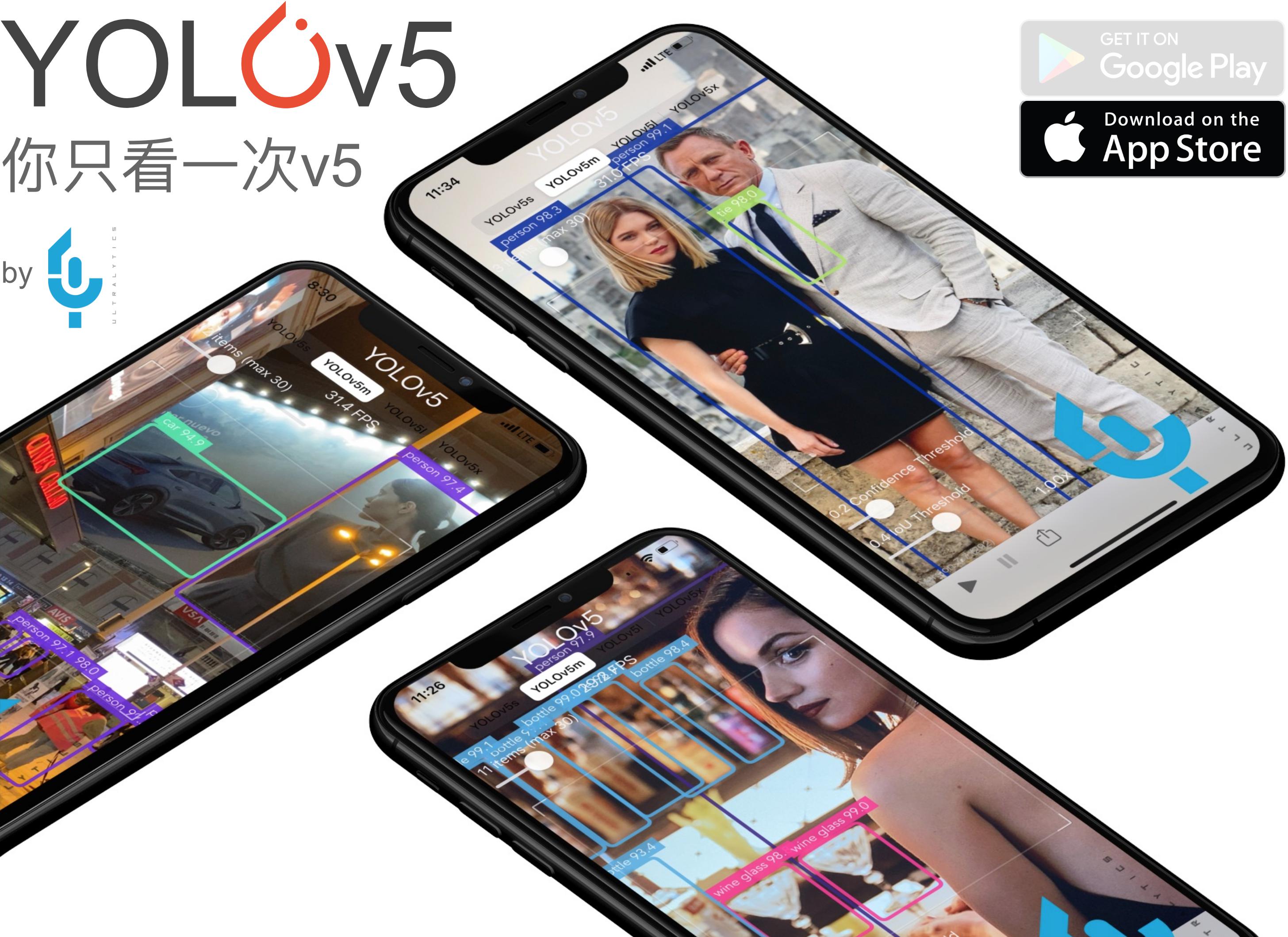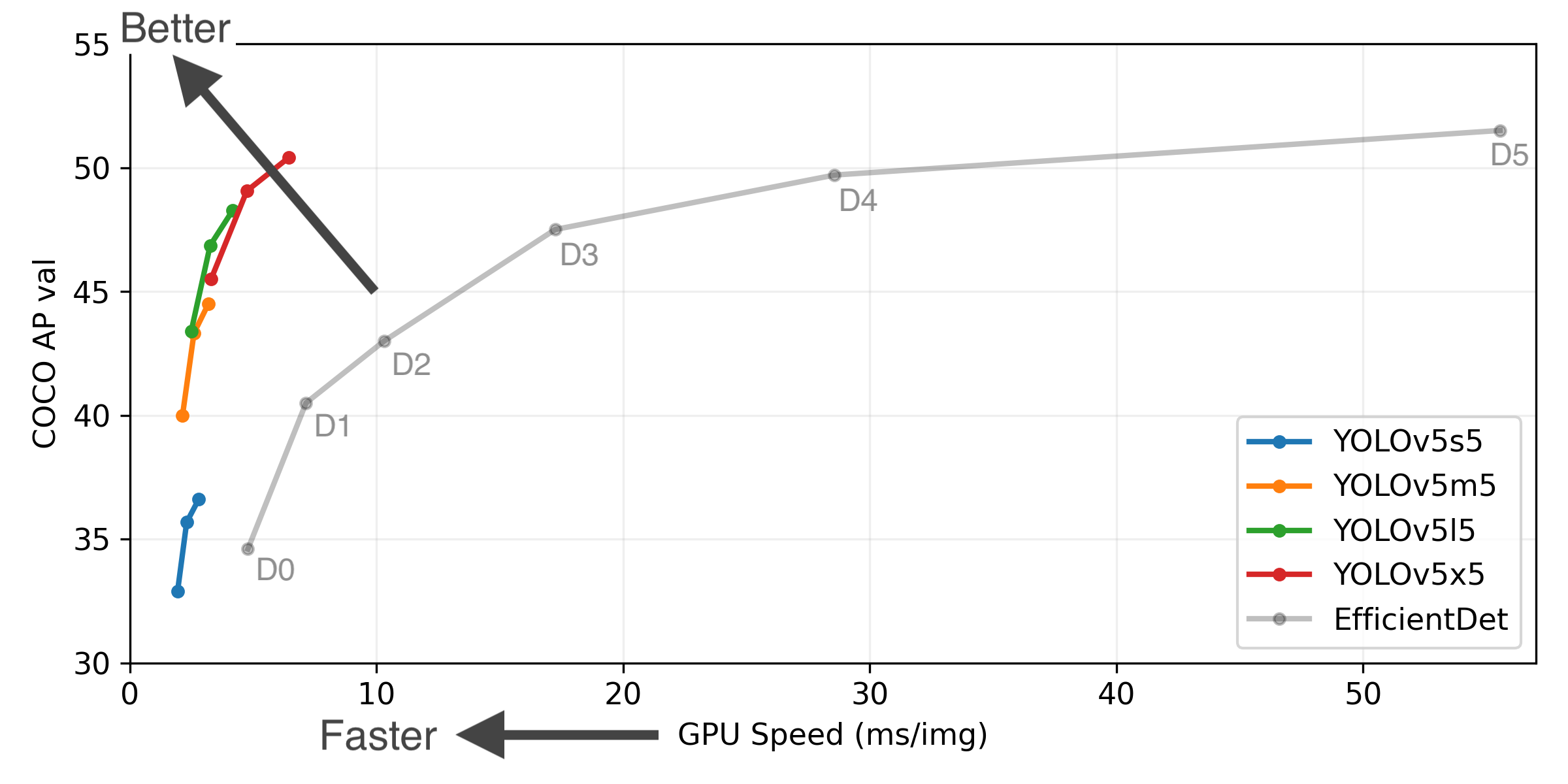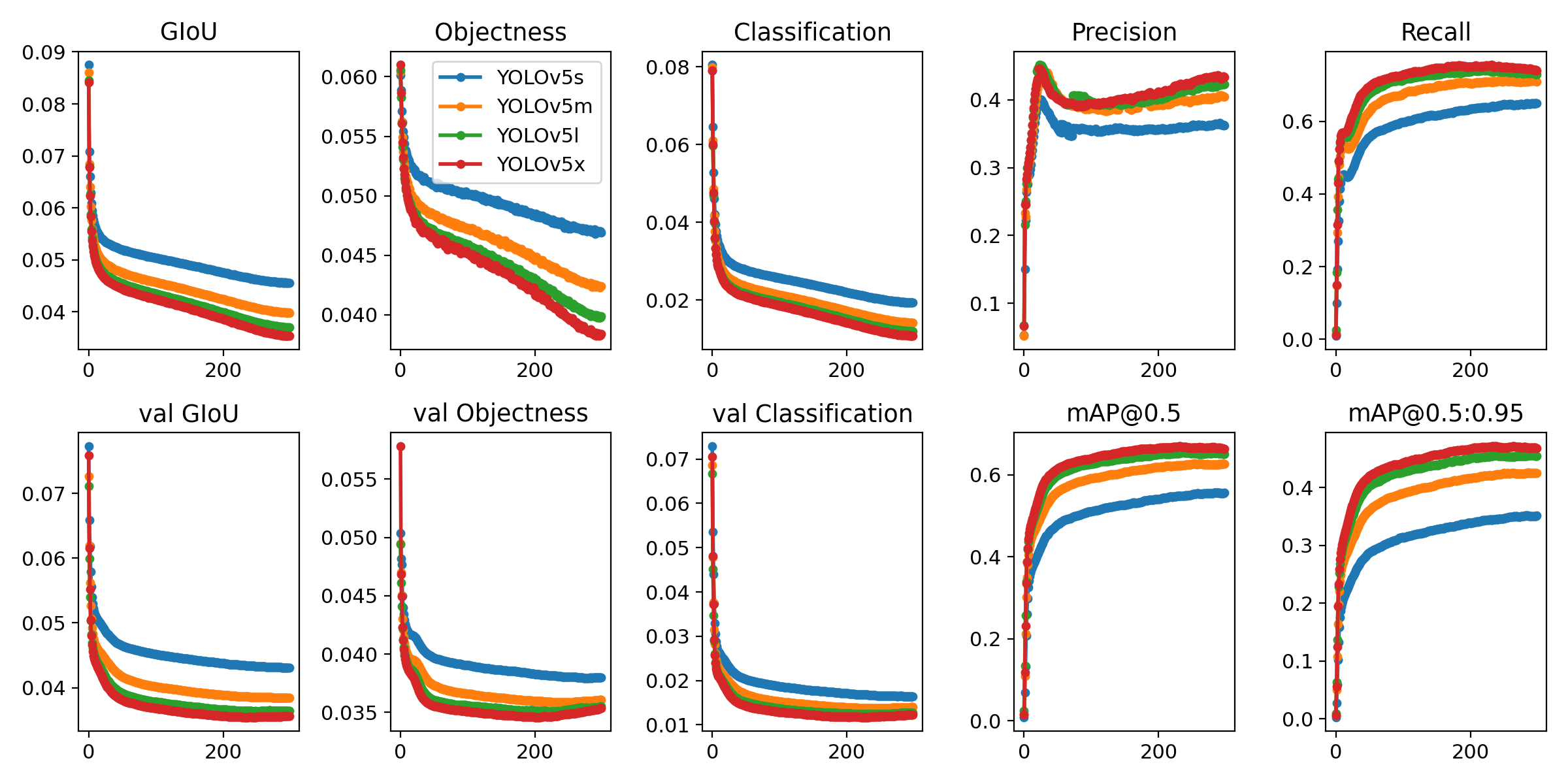# multiyolov5
**Repository Path**: Mr_xiaolong/multiyolov5
## Basic Information
- **Project Name**: multiyolov5
- **Description**: https://github.com/TomMao23/multiyolov5
- **Primary Language**: Unknown
- **License**: GPL-3.0
- **Default Branch**: zhaoxiaolong
- **Homepage**: None
- **GVP Project**: No
## Statistics
- **Stars**: 0
- **Forks**: 0
- **Created**: 2021-11-08
- **Last Updated**: 2021-11-08
## Categories & Tags
**Categories**: Uncategorized
**Tags**: None
## README
# Multi YOLO V5——Detection and Semantic Segmentation
## Overeview
This is my undergraduate graduation project which based on ultralytics YOLO V5 tag v5.0.
This multi-task model adds only a small amount of computation and inferential GPU memory (about 350MB) and is able to accomplish both object detection and semantic segmentation. Object detection metrics are slightly improved (compared to single-task YOLO) on my dataset (transfer from Cityscapes Instance Segmentation labels) and Cityscapes semantic segmentation metrics are shown below. **This repository will not be updated in the near future(after tag TomMao-2.0 realse)** and future version will **probably** be released to [MANA AI](http://www.manaai.cn). To save my time and facilitate handover, please forgive me for the following document will be written in Chinese.
[Demo Video](https://www.bilibili.com/video/BV1Yv411p7Js)

In the semantic segmentation section, I refer to the following code:
1. [zhanghang1989/PyTorch-Encoding: A CV toolkit for my papers. (github.com)](https://github.com/zhanghang1989/PyTorch-Encoding)
2. [CoinCheung/BiSeNet: Add bisenetv2. My implementation of BiSeNet (github.com)](https://github.com/CoinCheung/BiSeNet)
3. [ycszen/TorchSeg: Fast, modular reference implementation and easy training of Semantic Segmentation algorithms in PyTorch. (github.com)](https://github.com/ycszen/TorchSeg)
4. [YudeWang/semantic-segmentation-codebase: Codebase for semantic segmentation experiments (github.com)](https://github.com/YudeWang/semantic-segmentation-codebase)
这是我的本科毕设,基于ultralytics/yolov5多任务模型。以增加少量计算和显存为代价,同时完成目标检测和语义分割(1024×512输入约增加350MB,同尺寸增加一个bisenet需要约1.3GB,两个单任务模型独立输入还有额外的延时)。模型在Cityscapes语义分割数据集和由Cityscapes实例分割标签转换来的目标检测数据集上同时训练,检测结果略好于原版单任务的YOLOV5(仅限于此实验数据集),分割指标s模型验证集mIoU 0.73,测试集0.715;m模型验证集mIoU 0.75测试集0.735。由于将继续考研,tag 2.0发布后仓库近期不会再频繁更新,issue大概率不会回复(问题请参考以下Doc,震荡爆炸请尝试砍学习率。若后续考上研应该会在本仓库跟进yolov5的更新并尝试新分割结构、增加更多任务、多卡训练和部署的支持),未来版本**可能**由其他人整理/重构发布在[MANA AI](http://www.manaai.cn)。模型测试集指标和速度对比如上图(对比不完全公平,我用了yolo官方的COCO检测预训练模型,训练中使用了检测数据,但推理时会比以上模型多跑一个检测头),可视化如下图:
效果视频见[bilibili demo video](https://www.bilibili.com/video/BV1Yv411p7Js)




## Doc
### 0. Before Start 环境配置和数据集准备
#### (a) Environment
目前建议直接用主分支BS2021,近期不会再更新功能和结构,但如果issue提出BUG空闲时候会尽力在主分支修复
```bash
$ python -m pip install -r requirements.txt
$ python -m pip uninstall wandb
```
**注意!当前代码未做多卡训练和wandb支持, 不卸载训练大概率有bug**
#### (b) Dataset Prepare 数据集准备
本模型检测和分割数据集独立加载,不要求类别相同。当前支持Cityscapes语义分割数据集和实例分割标签生成的目标检测数据集(新增BDD100k混合Cityscapes训练支持,把BDD100k当做一个cityscapes的一个城市组织数据集格式),扩展语义分割数据集需要增改代码,继承BaseDataset类。目标检测数据集可以同原版yolo自行替换,参考原版YOLOV5文档和./data/cityscapes_det.yaml文件
**下载数据**:自行到官网下载Cityscapes数据集,把leftImg8bit和gtFine放入./data/citys文件夹中,也可使用citys中的bash脚本下载,需要先把脚本中的帐号密码改成你自己的
**数据预处理**:进到citys文件夹下运行citys文件夹的2yolo_filter.py生成目标检测标签.在citys文件夹中新建一个detdata文件夹,把生成的images和labels文件夹剪切到detdata中
注:比较费空间,只做Cityscapes实验的话可以考虑删除复制的图像,把leftImg8bit的图软链接到detdata中(但不要移动leftImg8bit和gtFine文件夹,分割要用)
```bash
$ cd ./data/citys
$ python 2yolo_filter.py
$ mkdir detdata
$ mv ./images ./detdata
$ mv ./labels ./detdata
```
2.0版本准备了4种分割Head的预训练模型。从可视化上更推荐psp和lab(感受野更大),速度上没有太大差别,base最快,psp第二,lab和bise接近:
`推荐指数:Lab和PSP > Base和BiSe`
**base.pt** 基础版本的分割head。16层(PAN1/8)输入,配置文件通道512。C3,通道略拓宽版本的C3SPP,dropout(0.1),1×1卷积到类别。速度精度综合效果不错,但是SPP配1/8图感受野其实不够大,s模型够好了,但m模型加深加宽后提高量不让人满意。
**bise.pt** 模仿BiSeNetV1的分割头,精度略大速度与base相似。16,19,22(PAN的1/8,1/16,1/32)输入,配置文件通道无效。ARM改成RFB2增强非线性BiSeNet每个Upsample后有一个3×3卷积refine,这里省计算放在Upsample前。BiSeNet的辅助损失系数是1,这里辅助损失太大结果不好。
**lab.pt** 模仿DeepLabV3+的分割头,验证集精度与psp和bise接近,速度略慢于psp和base,与bise相仿。4(或3),19(浅层1/8,PAN的1/16)输入,配置文件通道256。1/8图1×1卷积到48通道,1/16图过RFB1(ASPP类似的替代)。DeepLabV3+解码器部分用了浅层1/4和深层1/16,这里是1/8和1/16因为YOLO 1/4图通道数太少且太浅,并联后不3×3refine会比较破碎,refine则计算量太大。论文提到浅层大分辨率图通道少更利于训练,同论文到48。论文提到VOC用了ASPP全局更好,Cityscapes用了全局更差,这里未使用全局(实验中用了全局边缘会比较破碎,psp却是用了全局更好)。相比DeepLab解码器部分这里多了FFM注意力融合结构,为了用3×3砍了一点隐层减少计算量。
**psp.pt** 模仿PSPNet的分割头,目前精度最高,速度仅次于base。16,19,22三层融合输入,未找到合适的地方放辅助损失,放弃辅助损失
**[Pretrained Model百度网盘](https://pan.baidu.com/s/19z-g_TsC7YtmRiX5G568zg)** 提取码**cjxg**
pspv5s.pt表示psp头的yolov5s模型,pspv5m.pt表示yolov5m其他几个命名同理,预训练模型多是用上述cityscapes分割数据和实例分割生成的检测数据训练的,19个分割类,10个检测类。pspv5m_citybdd_conewaterbarrier.pt这个模型的分割部分使用了bdd100k和cityscapes两个数据集混合,检测部分数据不开放,各种车辆均归为vehicle,pedestrain和rider均归为person,bike和motorcycle均归为cycle,另有三角锥cone和水马waterbarrier类别。
### 1. Inference 推理图片、视频,用连续帧制作视频,向Cityscapes提交,测速
#### (a) 普通图片推理
```bash
$ python detect.py --weights ./pspv5s.pt或其他模型 --source data/images --conf 0.25 --img-size 1024
```
data/images里几张图片来自cityscapes测试集、bdd100k、apollo scape和yolo。此外data/test_imgs放了一些apollo的图,可以看看cityscapes训练后在apollo上的效果(使用了bdd100k训练的效果会再好一点)
结果图片在runs/detect文件夹中,也可以推理同时显示。
```bash
$ python detect.py --weights ./pspv5s.pt或其他模型 --source data/images --conf 0.25 --img-size 1024 --view-img
```
同原版YOLOV5,--weights写你的pt文件,--source写图片文件夹或者视频文件的路径,--conf检测阈值,--img-size为resize到模型的目标长边尺寸
#### (b) 同尺寸连续帧图片制作视频
```bash
$ python detect.py --weights ./pspv5s.pt或其他模型 --source 图片文件夹 --conf 0.25 --img-size 1024 --save-as-video
```
我只写了同尺寸图片制作视频的支持(例如Cityscapes提供的三段连续帧测试图片,bilibili的demo视频就是这些图),把你的图片放入同一文件夹内,注意若存在不同尺寸图片则结果视频会保存失败,若开了--no-save视频保存的图不会画结果(别开)
#### (c) 向Cityscapes提交测试集结果
```bash
$ python detect.py --weights ./pspv5s.pt或其他模型 --source 图片文件夹 --conf 0.25 --img-size 1024 --submit --no-save
```
开了--no-save不保存结果会快很多并省空间,把测试集6个文件夹的图片合并在一个文件夹进行推理,结束后会在此次的runs/detect/此次exp里找到一个results文件夹,里面是将trainid转换为id的结果,压缩上传官网即可
也可以分别推理6个文件夹,结果合并压缩上传
#### (d) 测速
测速就用(c)提交的参数来在同尺寸图片上测,或推理视频测。(a)图片推理没有开cudnn.benchmark,推理视频文件时候或是开了--submit或是开了--save-as-video时候会开启cudnn.benchmark,此时是真正的运行速度
注:cudnn.benchmark开启后第一帧图片会测试各种cudnn算子并记录,之后同尺寸的每帧图像都会使用最快的算子。cudnn.benchmark仅在同尺寸图像推理时候开启,否则每输入新尺寸图就会测一遍
yolov5默认使用float16推理,在20和30系列显卡差别不会很大,但在10和16系列显卡上不开cudnn.benchmark会慢非常多,因此建议测速在cudnn.benchmark开启时候测
### 2. Test 训练后测试模型
```bash
$ python test.py --data cityscapes_det.yaml --segdata ./data/citys --weights ./pspv5s.pt --img-size 1024 --base-size 1024
```
对比原版多两个参数: --segdata后写Cityscapes数据集的文件夹地址(现在只支持这个,可以参考SegmentationDataset.py自行扩展)
检测长边和分割长边参数分离,--img-size是检测长边 --base-size是分割长边,我的配置是把Cityscapes放在1024*512尺寸下推理,比较能兼顾速度精度,训练也是以此为目的调参的.
如果训练后测试你自己的数据集,用test_custom.py(训练中train_custom.py会测)
```bash
$ python test_custom.py --data 你的.yaml --segdata 你的分割数据路径 --weights ./pspv5s.pt --img-size 1024 --base-size 1024
```
### 3. Train 如何复现我的结果
训练前先下载对应的原版(注意我是在tag V5.0代码上改的)COCO预训练模型做初始化,见原版readme和weights/download_weights.sh脚本
```bash
$ python train.py --data cityscapes_det.yaml --cfg yolov5s_city_seg.yaml --batch-size 18 --epochs 200 --weights ./yolov5s.pt --workers 8 --label-smoothing 0.1 --img-size 832 --noautoanchor
```
不一定如示例训200轮(这是我训上述预训练模型为了让其尽量收敛的参数),建议最少训80轮,我一般训150到180轮
以上提到我的目标长边是1024,但这里是832,这个版本的代码为了节省显存增大batchsize和方便尝试加aux loss决定在832上训练调参,1024上推理.训练中输出的检测指标是832的,分割指标是1024的,建议训完再用test.py测试1024的结果
用--noautoanchor是因为COCO的anchor正好适合cityscapes1024的输入(832的autoanchor偏小了),能缓解anchor上的问题。即使如此832上训1024推理虽然指标高了,但可视化会看到一些anchor的问题。若你的显卡有11G,可以适当调小batchsize直接用1024来训
注意:为了加快训练我设置每10轮测试一次分割精度,最后40轮每轮测试分割精度
务必保证warmup期间(即我打印的accumulate达到目标值前)损失不发生过大震荡(现象:出现Nan,损失跑飞,严重影响到检测cls损失。一轮到两轮分割检测损失走高马上回落属正常现象),出现以上现象考虑砍学习率,当前学习率理论上各种batchsize应该都不会跑飞。
**[训你自己的数据集请看这里](https://github.com/TomMao23/multiyolov5/tree/BS2021/data/customdata)**
### 4. Code Guide 我修改了什么,调参/改进指南
1. 梯度积累
学习率和检测分割损失比(后者在train.py内未暴露出来)是一组非常重要的参数.必须清楚YOLOV5使用了梯度积累,不管你的batchsize是多少,“名义batchsize”都是作者预设的64。这意味着当你设置batchsize为16时,将会每4个batch才更新一次参数(具体积累几次看训练时候我打印的accumulate,第一次是目标值,后续是当前值),即实际的batchsize是你输入的batchsize的倍数中最接近64的那个(此处我将原代码修改为严格不超过64)。因此你输入的batchsize 17(实际51)要比16(实际64)小很多,调整学习率时候应注意到这点。过小的batchsize影响BN层也可能导致震荡,当前参数是在11G的显卡上设置的batchsize为18,弱修改了batchsize注意观察warmup期间的损失变化,accumulate达到目标值前发生较大震荡应考虑减小学习率。
2. common.py
此代码是YOLOV5中的常用基础操作类,我在其中增加了BiSeNet的ARM、FFM,RFB1、2(非RFBNet,魔改版本见代码注释),ASPP(接口上增加了用于砍通道的参数),ASPPs(先用1*1减少输入通道从而可以少砍一些中间通道),Attention(通道注意力,相当于不带3×3卷积的ARM,基础SE),DAPPM(见哈工大论文,这里效果不明显),PyramidPooling(PSPNet)
3. yolo.py
yolov5的模型主架构代码,包括Model类和检测要用的Detect类,我把新加的四种分割头类放在这个代码中(可能放common.py会更清爽些)。所有新加的模块要放入模型都必须要经过Model类,以下部分请重点关注:
(1) Model的初始化函数中,我在save中**手动添加了24层**(分割层号,检测是25)。原代码forward_onece采用了for循环前向推理,将后续会用到的层结果保存在列表中(会用到哪些层由parse函数对yaml配置文件解析得到,在初始化函数中调用了parse,需要保存的中间层号在save列表,forward时候按照save序号将对应层中间结果存入y列表),目前的方法中由于我手动加入24层,检测层运行结束后,会返回x(检测结果)和y [-2] (分割结果)。因此若修改了配置文件增加了新的层(例如给最新的P6模型增加分割层),务必修改Model的初始化函数把24换成新的分割层号(这确实不是个好接口,赶时间,另外别把24改成-2,看yolo原版代码就知道这么改不管用)。另外yolov5原作者在很多代码中默认了检测层是最后一层,务必在配置中把检测层放在最后一层。
(2) Model的解析函数parse_model从yaml文件解析配置,如果想增加新的模块首先在common.py或yolo.py中实现该类,在parse_model中仿照写出该类的解析方法,再在配置文件中写入配置。如果仿照我的分割头类接口设计新增分割头,仅需实现类,在parse_model的解析分割头的支持列表中加入该类名即可。
4. models/yolov5s_city_seg.yaml
模型配置文件,可以看到我在检测层前面加了分割层配置,并增加了分割类别(cityscapes是19)。推理不同head预训练模型不用修改,想训练不同head模型需要注释和解注释(psp、base和lab不用再改train.py但bise还要注释和解注释train.py的两个地方加入aux loss,后续会说明,接口设计缺陷,但暂时没时间改,实际上用psp、base、lab就够了,除非你想增加辅助损失)。s,m,l模型参照原版,区别仅在控制深度和宽度的depth_multiple, width_multiple数值(base,psp和lab的分割头也会随s,m,l自动放缩)。
5. data/cityscapes_det.yaml
检测数据集配置,同原版,新增了分割数据集地址,train.py读分割数据地址是按这里配置的
6. test.py
新增了分割测试函数
7. utils/loss.py
新增了带aux的分割CE损失(目前用这个),分割Focal loss(比较充分的实验说明效果不好,至少低1个点),OHEM(理论上应该好于CE,实际低了零点几个点,和学习率和损失比有一定关系,梯度积累机制上似乎也有点bug),总之多数情况建议用CE,类别极不平衡时候再考虑ohem和focal loss。
8. utils/metrics.py
新增了fitness2函数用于train时候选模型,包括P,R,AP@.5,AP@.5:.95和mIoU的比例。新增了计算mIoU函数。
9. detect.py
新增了画分割和叠加图、同尺寸图保存视频以及用于提交的trainid转id功能(见上面推理部分),修改了开cudnn.benchmark的情况
10. SegmentationDataset.py
分割数据处理类。原始代码来自pytorch-ecoding项目,魔改了一番,增加了colorjittor,增加了resize长边非均匀采样,修改了crop方式,修改了testval mode的方式,废除了val mode(比testval mode快很多,但是测出的值不是准确精度.在训练图片尺寸不同时候可以用这个,也可以用testval把batchsize设为1),图片尺寸相同时训练中和后都用testval mode。目前问题在于处理繁杂加载效率不是很高,对CPU和磁盘要求比较高(colab和kaggle上很慢)。训练过程中可能会卡一段时间或出现only test a child process,程序并没有死,等待一小段时间就好了,属于bug的正常现象。训练其他分割数据例如BDD100k需要仿照cityscapes继承基础类(已实现cityscapes和bdd100k混合类,以及示例用的custom_data类),特别是标签转换部分,注意pad的像素为255和普通ignore类别加载时候一并转换成-1,有些数据集id需要转成trainid(目前的custom_data类是针对不用转id,ignore标记为255的数据,同bdd100k)。
11. train.py
训练流程是每个batch跑一组检测数据backward,然后跑一组分割数据backward,然后accumulate后统一更新参数。每10轮测一次分割精度,最后40轮每轮测,测分割时候才会更新best.pt。(之所以这么做是因为testval mode的loader有点问题导致部分子进程死亡,测分割很慢,我机器上1分钟多点)。另外目前还没写多卡训练的支持,暂时用不了多卡。
时间关系ohem和CE接口没保持一致,循环中CE接口aux不同个数输入求损失处没保持一致,替换带aux loss的分割头训练时候要注释解注释train.py这两个地方(用很长的-----注释标出)。
12. 一些设计经验
- 分割头入口尽量多一点非线性会使分割和检测都比较好(例如加深一点,PSP和bise里用RFB2就是如此)。分割头过于简单时会变成检测的辅助,此时检测涨点可能比用较深的分割头时候还高,但分割点很难提上去。
- 建议用16,19,22层而不要用17,20,23层作为分割的输入。用后者对分割有好处,原因是C3本身起到了一个特征融合的作用,但是检测会掉2到3个点,因为检测头仅仅是在17,20,23后加个1*1。使用前者仅仅并联了通道不算是融合(至少还得来个1×1),需要引入额外的模块来融合,比起用后者会加计算量,但是把C3留给检测做变换,检测不掉反而会涨点(分割会优化特征),分割也可以做到用后者同样精度,当然同精度下速度会慢点。
- 融合时用cat后1×1包含了add加激活的效果,但并不总是比add好,相比这两者FFM是一个效果不错的融合方式。
- 深浅差距较大的层融合最好用3×3效果比较好,有时候宁可砍掉点通道用3×3
- DeepLabV3+的经验值得学习,语义层比细节层通道多更容易拟合数据,分割结果也不容易破碎。
- 用了浅层图的解码器要改深一点给足够的非线性让其融合(比如base可以直接256就分类,lab就得来)
- dropout多数情况作用不大(mmsegmentation和bisenet原作均未用dropout),与BN的冲突也没理论上那么大,输出层前加0.1的dropout可选,区别不大(pytorch-encoding等常用写法)
- 空洞卷积效果很给力但计算量也很大, ASPP等必须砍通道。
- 输入分辨率没那么高(1024×512,很多模型是2048×1024),1/32图处加aux head和loss效果似乎不太好,1/16加不错
- 同上,lab头的实验证明了1/16为主也是可行的,但我的其他实验证明使用1/32为主和1/8融合效果不好(推测原因是半尺寸的1/32太小)
- yolo的FPN和PAN用的是cat,19 cat包含了4,理论上可以学出来,然而实验表明当做细节层时候直接用第4层比用16层好,语义层融合(或单输入层)自然是用16,19,22比浅层好,用17,20,23会和检测冲突。
- 当前的backbone其实感受野本身也偏小,更合理的改进是不只在分割head扩大,backbone也应该适当扩大感受野
- yolov5新的P6模型可能很适合做这个(不用ASPP而仅使用多尺度层融合),我没来得及实验
13. 一些调参和其他经验
- 输入长边尺寸是1024所以空洞卷积的膨胀率没必要那么大(deeplabv3+原文1/16处6,12,18),砍半或者比半略大就够了,太大速度降得多,精度还没收益。
- BiSeNet的经验表明分割模型通道没必要那么多,128就不错了,但是一些多尺度的中间通道提高有助于精度(SPP,ASPP,RFB等,当然有的速度代价也不小,特别是空洞卷积。
- batchsize太小对BN不好,震荡可能要砍学习率,但是crop太小或是小图训大图跑也不好,6G卡毫无疑问在832训832或者1024跑,11G卡考虑1024训1024跑(果然增加多卡支持和大图和syncbn才是正道,money is all you need!!!)
- 检测和分割的尺度不应该差异太大,否则两任务会冲突导致精度都下降。
- 训练和推理尺度不应该差异太大(不只指标的问题)。
- resize长边非均匀采样后目标尺寸的指标比均匀采样要好
- 尺度是个模型和数据两方面的问题,模型感受野要够大够灵活(多尺度融合),采样上也要在训练时让模型见过各种尺度样本(太小apollo天空图过不去,太大自身精度下降,非均匀采样在这里起到作用,更关注目标尺度样本,“见过”极端尺度样本,当然模型结构更重要)
- 原yolo的测试图片和一张apollo带桥(cityscapes没有,但是bdd100k有)且光线条件较差的图片被保留,展示模型何时不起作用(COCO尺度和Cityscapes很不一样)
### 5.自问自答,节省issue时间
1. 训练时候报only test a child process或者加载卡住是BUG,但是程序其实没有死,等待一会(若有谁解决了加载效率和这个问题,烦请issue戳一下)
2. testval mode加载器比较慢,但正常不应该达到2分钟以上
3. 没看过yolo源码可以魔改吗? -可以,直接在我的分割头和配置文件上改,可以不用去看解析函数等代码。涉及修改backbone,分割层不在24层,接口不同的分割头时候需要至少读过yolo.py相关代码特别是Model的初始化、parse和run_once三部分
4. 训这个前建议至少训过原版yolov5,很多流程和原版一样
5. 我把train_custom.py里的分割验证loader的batchsize改成1了,目的是兼顾有不同尺寸的数据集,同尺寸数据集嫌慢的可以手动改一下代码把分割验证batchsize调大。不同尺寸也嫌慢的可以去train_custom.py解注释val mode的loader然后把testval mode的loader注释
6. 训自己数据集看上面的教程链接,但还是建议读一下SegmentationDataset.py做了什么,必要时候自己实现类
7. 代码接口和命名风格问题。这个仓库的代码有的是我自己写的,有的是我原样搬过来用的,更多是我参考论文及对应源码后抄过来实验修改的,所以接口设计和命名风格不一致,请见谅。
8. 大量注释问题。在开始动手前我花了一个星期阅读yolov5的代码,为了节省时间和不产生歧义以及区分原版注释和我的记录,我在代码中写了大量中文注释。这些注释可能帮助初学者理解yolov5的一些函数,但未经过严格复查,如有错误注释或历史遗留注释请见谅。
9. 这个项目没有什么创新,代码也很乱很烂,但是受益于yolov5的工作速度精度性能很好,因此值得开源出来
--------
原版readme分割线
--------

 This repository represents Ultralytics open-source research into future object detection methods, and incorporates lessons learned and best practices evolved over thousands of hours of training and evolution on anonymized client datasets. **All code and models are under active development, and are subject to modification or deletion without notice.** Use at your own risk.
This repository represents Ultralytics open-source research into future object detection methods, and incorporates lessons learned and best practices evolved over thousands of hours of training and evolution on anonymized client datasets. **All code and models are under active development, and are subject to modification or deletion without notice.** Use at your own risk.

YOLOv5-P5 640 Figure (click to expand)

Figure Notes (click to expand)
* GPU Speed measures end-to-end time per image averaged over 5000 COCO val2017 images using a V100 GPU with batch size 32, and includes image preprocessing, PyTorch FP16 inference, postprocessing and NMS.
* EfficientDet data from [google/automl](https://github.com/google/automl) at batch size 8.
* **Reproduce** by `python test.py --task study --data coco.yaml --iou 0.7 --weights yolov5s6.pt yolov5m6.pt yolov5l6.pt yolov5x6.pt`
- **April 11, 2021**: [v5.0 release](https://github.com/ultralytics/yolov5/releases/tag/v5.0): YOLOv5-P6 1280 models, [AWS](https://github.com/ultralytics/yolov5/wiki/AWS-Quickstart), [Supervise.ly](https://github.com/ultralytics/yolov5/issues/2518) and [YouTube](https://github.com/ultralytics/yolov5/pull/2752) integrations.
- **January 5, 2021**: [v4.0 release](https://github.com/ultralytics/yolov5/releases/tag/v4.0): nn.SiLU() activations, [Weights & Biases](https://wandb.ai/site?utm_campaign=repo_yolo_readme) logging, [PyTorch Hub](https://pytorch.org/hub/ultralytics_yolov5/) integration.
- **August 13, 2020**: [v3.0 release](https://github.com/ultralytics/yolov5/releases/tag/v3.0): nn.Hardswish() activations, data autodownload, native AMP.
- **July 23, 2020**: [v2.0 release](https://github.com/ultralytics/yolov5/releases/tag/v2.0): improved model definition, training and mAP.
## Pretrained Checkpoints
[assets]: https://github.com/ultralytics/yolov5/releases
Model |size
(pixels) |mAPval
0.5:0.95 |mAPtest
0.5:0.95 |mAPval
0.5 |Speed
V100 (ms) | |params
(M) |FLOPS
640 (B)
--- |--- |--- |--- |--- |--- |---|--- |---
[YOLOv5s][assets] |640 |36.7 |36.7 |55.4 |**2.0** | |7.3 |17.0
[YOLOv5m][assets] |640 |44.5 |44.5 |63.3 |2.7 | |21.4 |51.3
[YOLOv5l][assets] |640 |48.2 |48.2 |66.9 |3.8 | |47.0 |115.4
[YOLOv5x][assets] |640 |**50.4** |**50.4** |**68.8** |6.1 | |87.7 |218.8
| | | | | | || |
[YOLOv5s6][assets] |1280 |43.3 |43.3 |61.9 |**4.3** | |12.7 |17.4
[YOLOv5m6][assets] |1280 |50.5 |50.5 |68.7 |8.4 | |35.9 |52.4
[YOLOv5l6][assets] |1280 |53.4 |53.4 |71.1 |12.3 | |77.2 |117.7
[YOLOv5x6][assets] |1280 |**54.4** |**54.4** |**72.0** |22.4 | |141.8 |222.9
| | | | | | || |
[YOLOv5x6][assets] TTA |1280 |**55.0** |**55.0** |**72.0** |70.8 | |- |-
Table Notes (click to expand)
* APtest denotes COCO [test-dev2017](http://cocodataset.org/#upload) server results, all other AP results denote val2017 accuracy.
* AP values are for single-model single-scale unless otherwise noted. **Reproduce mAP** by `python test.py --data coco.yaml --img 640 --conf 0.001 --iou 0.65`
* SpeedGPU averaged over 5000 COCO val2017 images using a GCP [n1-standard-16](https://cloud.google.com/compute/docs/machine-types#n1_standard_machine_types) V100 instance, and includes FP16 inference, postprocessing and NMS. **Reproduce speed** by `python test.py --data coco.yaml --img 640 --conf 0.25 --iou 0.45`
* All checkpoints are trained to 300 epochs with default settings and hyperparameters (no autoaugmentation).
* Test Time Augmentation ([TTA](https://github.com/ultralytics/yolov5/issues/303)) includes reflection and scale augmentation. **Reproduce TTA** by `python test.py --data coco.yaml --img 1536 --iou 0.7 --augment`
## Requirements
Python 3.8 or later with all [requirements.txt](https://github.com/ultralytics/yolov5/blob/master/requirements.txt) dependencies installed, including `torch>=1.7`. To install run:
```bash
$ pip install -r requirements.txt
```
## Tutorials
* [Train Custom Data](https://github.com/ultralytics/yolov5/wiki/Train-Custom-Data) 🚀 RECOMMENDED
* [Tips for Best Training Results](https://github.com/ultralytics/yolov5/wiki/Tips-for-Best-Training-Results) ☘️ RECOMMENDED
* [Weights & Biases Logging](https://github.com/ultralytics/yolov5/issues/1289) 🌟 NEW
* [Supervisely Ecosystem](https://github.com/ultralytics/yolov5/issues/2518) 🌟 NEW
* [Multi-GPU Training](https://github.com/ultralytics/yolov5/issues/475)
* [PyTorch Hub](https://github.com/ultralytics/yolov5/issues/36) ⭐ NEW
* [ONNX and TorchScript Export](https://github.com/ultralytics/yolov5/issues/251)
* [Test-Time Augmentation (TTA)](https://github.com/ultralytics/yolov5/issues/303)
* [Model Ensembling](https://github.com/ultralytics/yolov5/issues/318)
* [Model Pruning/Sparsity](https://github.com/ultralytics/yolov5/issues/304)
* [Hyperparameter Evolution](https://github.com/ultralytics/yolov5/issues/607)
* [Transfer Learning with Frozen Layers](https://github.com/ultralytics/yolov5/issues/1314) ⭐ NEW
* [TensorRT Deployment](https://github.com/wang-xinyu/tensorrtx)
## Environments
YOLOv5 may be run in any of the following up-to-date verified environments (with all dependencies including [CUDA](https://developer.nvidia.com/cuda)/[CUDNN](https://developer.nvidia.com/cudnn), [Python](https://www.python.org/) and [PyTorch](https://pytorch.org/) preinstalled):
- **Google Colab and Kaggle** notebooks with free GPU: 
 - **Google Cloud** Deep Learning VM. See [GCP Quickstart Guide](https://github.com/ultralytics/yolov5/wiki/GCP-Quickstart)
- **Amazon** Deep Learning AMI. See [AWS Quickstart Guide](https://github.com/ultralytics/yolov5/wiki/AWS-Quickstart)
- **Docker Image**. See [Docker Quickstart Guide](https://github.com/ultralytics/yolov5/wiki/Docker-Quickstart)
- **Google Cloud** Deep Learning VM. See [GCP Quickstart Guide](https://github.com/ultralytics/yolov5/wiki/GCP-Quickstart)
- **Amazon** Deep Learning AMI. See [AWS Quickstart Guide](https://github.com/ultralytics/yolov5/wiki/AWS-Quickstart)
- **Docker Image**. See [Docker Quickstart Guide](https://github.com/ultralytics/yolov5/wiki/Docker-Quickstart)  ## Inference
`detect.py` runs inference on a variety of sources, downloading models automatically from the [latest YOLOv5 release](https://github.com/ultralytics/yolov5/releases) and saving results to `runs/detect`.
```bash
$ python detect.py --source 0 # webcam
file.jpg # image
file.mp4 # video
path/ # directory
path/*.jpg # glob
'https://youtu.be/NUsoVlDFqZg' # YouTube video
'rtsp://example.com/media.mp4' # RTSP, RTMP, HTTP stream
```
To run inference on example images in `data/images`:
```bash
$ python detect.py --source data/images --weights yolov5s.pt --conf 0.25
Namespace(agnostic_nms=False, augment=False, classes=None, conf_thres=0.25, device='', exist_ok=False, img_size=640, iou_thres=0.45, name='exp', project='runs/detect', save_conf=False, save_txt=False, source='data/images/', update=False, view_img=False, weights=['yolov5s.pt'])
YOLOv5 v4.0-96-g83dc1b4 torch 1.7.0+cu101 CUDA:0 (Tesla V100-SXM2-16GB, 16160.5MB)
Fusing layers...
Model Summary: 224 layers, 7266973 parameters, 0 gradients, 17.0 GFLOPS
image 1/2 /content/yolov5/data/images/bus.jpg: 640x480 4 persons, 1 bus, Done. (0.010s)
image 2/2 /content/yolov5/data/images/zidane.jpg: 384x640 2 persons, 1 tie, Done. (0.011s)
Results saved to runs/detect/exp2
Done. (0.103s)
```
## Inference
`detect.py` runs inference on a variety of sources, downloading models automatically from the [latest YOLOv5 release](https://github.com/ultralytics/yolov5/releases) and saving results to `runs/detect`.
```bash
$ python detect.py --source 0 # webcam
file.jpg # image
file.mp4 # video
path/ # directory
path/*.jpg # glob
'https://youtu.be/NUsoVlDFqZg' # YouTube video
'rtsp://example.com/media.mp4' # RTSP, RTMP, HTTP stream
```
To run inference on example images in `data/images`:
```bash
$ python detect.py --source data/images --weights yolov5s.pt --conf 0.25
Namespace(agnostic_nms=False, augment=False, classes=None, conf_thres=0.25, device='', exist_ok=False, img_size=640, iou_thres=0.45, name='exp', project='runs/detect', save_conf=False, save_txt=False, source='data/images/', update=False, view_img=False, weights=['yolov5s.pt'])
YOLOv5 v4.0-96-g83dc1b4 torch 1.7.0+cu101 CUDA:0 (Tesla V100-SXM2-16GB, 16160.5MB)
Fusing layers...
Model Summary: 224 layers, 7266973 parameters, 0 gradients, 17.0 GFLOPS
image 1/2 /content/yolov5/data/images/bus.jpg: 640x480 4 persons, 1 bus, Done. (0.010s)
image 2/2 /content/yolov5/data/images/zidane.jpg: 384x640 2 persons, 1 tie, Done. (0.011s)
Results saved to runs/detect/exp2
Done. (0.103s)
```
 ### PyTorch Hub
To run **batched inference** with YOLOv5 and [PyTorch Hub](https://github.com/ultralytics/yolov5/issues/36):
```python
import torch
# Model
model = torch.hub.load('ultralytics/yolov5', 'yolov5s')
# Images
dir = 'https://github.com/ultralytics/yolov5/raw/master/data/images/'
imgs = [dir + f for f in ('zidane.jpg', 'bus.jpg')] # batch of images
# Inference
results = model(imgs)
results.print() # or .show(), .save()
```
## Training
Run commands below to reproduce results on [COCO](https://github.com/ultralytics/yolov5/blob/master/data/scripts/get_coco.sh) dataset (dataset auto-downloads on first use). Training times for YOLOv5s/m/l/x are 2/4/6/8 days on a single V100 (multi-GPU times faster). Use the largest `--batch-size` your GPU allows (batch sizes shown for 16 GB devices).
```bash
$ python train.py --data coco.yaml --cfg yolov5s.yaml --weights '' --batch-size 64
yolov5m 40
yolov5l 24
yolov5x 16
```
### PyTorch Hub
To run **batched inference** with YOLOv5 and [PyTorch Hub](https://github.com/ultralytics/yolov5/issues/36):
```python
import torch
# Model
model = torch.hub.load('ultralytics/yolov5', 'yolov5s')
# Images
dir = 'https://github.com/ultralytics/yolov5/raw/master/data/images/'
imgs = [dir + f for f in ('zidane.jpg', 'bus.jpg')] # batch of images
# Inference
results = model(imgs)
results.print() # or .show(), .save()
```
## Training
Run commands below to reproduce results on [COCO](https://github.com/ultralytics/yolov5/blob/master/data/scripts/get_coco.sh) dataset (dataset auto-downloads on first use). Training times for YOLOv5s/m/l/x are 2/4/6/8 days on a single V100 (multi-GPU times faster). Use the largest `--batch-size` your GPU allows (batch sizes shown for 16 GB devices).
```bash
$ python train.py --data coco.yaml --cfg yolov5s.yaml --weights '' --batch-size 64
yolov5m 40
yolov5l 24
yolov5x 16
```
 ## Citation
[](https://zenodo.org/badge/latestdoi/264818686)
## About Us
Ultralytics is a U.S.-based particle physics and AI startup with over 6 years of expertise supporting government, academic and business clients. We offer a wide range of vision AI services, spanning from simple expert advice up to delivery of fully customized, end-to-end production solutions, including:
- **Cloud-based AI** systems operating on **hundreds of HD video streams in realtime.**
- **Edge AI** integrated into custom iOS and Android apps for realtime **30 FPS video inference.**
- **Custom data training**, hyperparameter evolution, and model exportation to any destination.
For business inquiries and professional support requests please visit us at https://www.ultralytics.com.
## Contact
**Issues should be raised directly in the repository.** For business inquiries or professional support requests please visit https://www.ultralytics.com or email Glenn Jocher at glenn.jocher@ultralytics.com.
## Citation
[](https://zenodo.org/badge/latestdoi/264818686)
## About Us
Ultralytics is a U.S.-based particle physics and AI startup with over 6 years of expertise supporting government, academic and business clients. We offer a wide range of vision AI services, spanning from simple expert advice up to delivery of fully customized, end-to-end production solutions, including:
- **Cloud-based AI** systems operating on **hundreds of HD video streams in realtime.**
- **Edge AI** integrated into custom iOS and Android apps for realtime **30 FPS video inference.**
- **Custom data training**, hyperparameter evolution, and model exportation to any destination.
For business inquiries and professional support requests please visit us at https://www.ultralytics.com.
## Contact
**Issues should be raised directly in the repository.** For business inquiries or professional support requests please visit https://www.ultralytics.com or email Glenn Jocher at glenn.jocher@ultralytics.com.



 - **Google Cloud** Deep Learning VM. See [GCP Quickstart Guide](https://github.com/ultralytics/yolov5/wiki/GCP-Quickstart)
- **Amazon** Deep Learning AMI. See [AWS Quickstart Guide](https://github.com/ultralytics/yolov5/wiki/AWS-Quickstart)
- **Docker Image**. See [Docker Quickstart Guide](https://github.com/ultralytics/yolov5/wiki/Docker-Quickstart)
- **Google Cloud** Deep Learning VM. See [GCP Quickstart Guide](https://github.com/ultralytics/yolov5/wiki/GCP-Quickstart)
- **Amazon** Deep Learning AMI. See [AWS Quickstart Guide](https://github.com/ultralytics/yolov5/wiki/AWS-Quickstart)
- **Docker Image**. See [Docker Quickstart Guide](https://github.com/ultralytics/yolov5/wiki/Docker-Quickstart)  ## Inference
`detect.py` runs inference on a variety of sources, downloading models automatically from the [latest YOLOv5 release](https://github.com/ultralytics/yolov5/releases) and saving results to `runs/detect`.
```bash
$ python detect.py --source 0 # webcam
file.jpg # image
file.mp4 # video
path/ # directory
path/*.jpg # glob
'https://youtu.be/NUsoVlDFqZg' # YouTube video
'rtsp://example.com/media.mp4' # RTSP, RTMP, HTTP stream
```
To run inference on example images in `data/images`:
```bash
$ python detect.py --source data/images --weights yolov5s.pt --conf 0.25
Namespace(agnostic_nms=False, augment=False, classes=None, conf_thres=0.25, device='', exist_ok=False, img_size=640, iou_thres=0.45, name='exp', project='runs/detect', save_conf=False, save_txt=False, source='data/images/', update=False, view_img=False, weights=['yolov5s.pt'])
YOLOv5 v4.0-96-g83dc1b4 torch 1.7.0+cu101 CUDA:0 (Tesla V100-SXM2-16GB, 16160.5MB)
Fusing layers...
Model Summary: 224 layers, 7266973 parameters, 0 gradients, 17.0 GFLOPS
image 1/2 /content/yolov5/data/images/bus.jpg: 640x480 4 persons, 1 bus, Done. (0.010s)
image 2/2 /content/yolov5/data/images/zidane.jpg: 384x640 2 persons, 1 tie, Done. (0.011s)
Results saved to runs/detect/exp2
Done. (0.103s)
```
## Inference
`detect.py` runs inference on a variety of sources, downloading models automatically from the [latest YOLOv5 release](https://github.com/ultralytics/yolov5/releases) and saving results to `runs/detect`.
```bash
$ python detect.py --source 0 # webcam
file.jpg # image
file.mp4 # video
path/ # directory
path/*.jpg # glob
'https://youtu.be/NUsoVlDFqZg' # YouTube video
'rtsp://example.com/media.mp4' # RTSP, RTMP, HTTP stream
```
To run inference on example images in `data/images`:
```bash
$ python detect.py --source data/images --weights yolov5s.pt --conf 0.25
Namespace(agnostic_nms=False, augment=False, classes=None, conf_thres=0.25, device='', exist_ok=False, img_size=640, iou_thres=0.45, name='exp', project='runs/detect', save_conf=False, save_txt=False, source='data/images/', update=False, view_img=False, weights=['yolov5s.pt'])
YOLOv5 v4.0-96-g83dc1b4 torch 1.7.0+cu101 CUDA:0 (Tesla V100-SXM2-16GB, 16160.5MB)
Fusing layers...
Model Summary: 224 layers, 7266973 parameters, 0 gradients, 17.0 GFLOPS
image 1/2 /content/yolov5/data/images/bus.jpg: 640x480 4 persons, 1 bus, Done. (0.010s)
image 2/2 /content/yolov5/data/images/zidane.jpg: 384x640 2 persons, 1 tie, Done. (0.011s)
Results saved to runs/detect/exp2
Done. (0.103s)
```
 ### PyTorch Hub
To run **batched inference** with YOLOv5 and [PyTorch Hub](https://github.com/ultralytics/yolov5/issues/36):
```python
import torch
# Model
model = torch.hub.load('ultralytics/yolov5', 'yolov5s')
# Images
dir = 'https://github.com/ultralytics/yolov5/raw/master/data/images/'
imgs = [dir + f for f in ('zidane.jpg', 'bus.jpg')] # batch of images
# Inference
results = model(imgs)
results.print() # or .show(), .save()
```
## Training
Run commands below to reproduce results on [COCO](https://github.com/ultralytics/yolov5/blob/master/data/scripts/get_coco.sh) dataset (dataset auto-downloads on first use). Training times for YOLOv5s/m/l/x are 2/4/6/8 days on a single V100 (multi-GPU times faster). Use the largest `--batch-size` your GPU allows (batch sizes shown for 16 GB devices).
```bash
$ python train.py --data coco.yaml --cfg yolov5s.yaml --weights '' --batch-size 64
yolov5m 40
yolov5l 24
yolov5x 16
```
### PyTorch Hub
To run **batched inference** with YOLOv5 and [PyTorch Hub](https://github.com/ultralytics/yolov5/issues/36):
```python
import torch
# Model
model = torch.hub.load('ultralytics/yolov5', 'yolov5s')
# Images
dir = 'https://github.com/ultralytics/yolov5/raw/master/data/images/'
imgs = [dir + f for f in ('zidane.jpg', 'bus.jpg')] # batch of images
# Inference
results = model(imgs)
results.print() # or .show(), .save()
```
## Training
Run commands below to reproduce results on [COCO](https://github.com/ultralytics/yolov5/blob/master/data/scripts/get_coco.sh) dataset (dataset auto-downloads on first use). Training times for YOLOv5s/m/l/x are 2/4/6/8 days on a single V100 (multi-GPU times faster). Use the largest `--batch-size` your GPU allows (batch sizes shown for 16 GB devices).
```bash
$ python train.py --data coco.yaml --cfg yolov5s.yaml --weights '' --batch-size 64
yolov5m 40
yolov5l 24
yolov5x 16
```
 ## Citation
[](https://zenodo.org/badge/latestdoi/264818686)
## About Us
Ultralytics is a U.S.-based particle physics and AI startup with over 6 years of expertise supporting government, academic and business clients. We offer a wide range of vision AI services, spanning from simple expert advice up to delivery of fully customized, end-to-end production solutions, including:
- **Cloud-based AI** systems operating on **hundreds of HD video streams in realtime.**
- **Edge AI** integrated into custom iOS and Android apps for realtime **30 FPS video inference.**
- **Custom data training**, hyperparameter evolution, and model exportation to any destination.
For business inquiries and professional support requests please visit us at https://www.ultralytics.com.
## Contact
**Issues should be raised directly in the repository.** For business inquiries or professional support requests please visit https://www.ultralytics.com or email Glenn Jocher at glenn.jocher@ultralytics.com.
## Citation
[](https://zenodo.org/badge/latestdoi/264818686)
## About Us
Ultralytics is a U.S.-based particle physics and AI startup with over 6 years of expertise supporting government, academic and business clients. We offer a wide range of vision AI services, spanning from simple expert advice up to delivery of fully customized, end-to-end production solutions, including:
- **Cloud-based AI** systems operating on **hundreds of HD video streams in realtime.**
- **Edge AI** integrated into custom iOS and Android apps for realtime **30 FPS video inference.**
- **Custom data training**, hyperparameter evolution, and model exportation to any destination.
For business inquiries and professional support requests please visit us at https://www.ultralytics.com.
## Contact
**Issues should be raised directly in the repository.** For business inquiries or professional support requests please visit https://www.ultralytics.com or email Glenn Jocher at glenn.jocher@ultralytics.com.